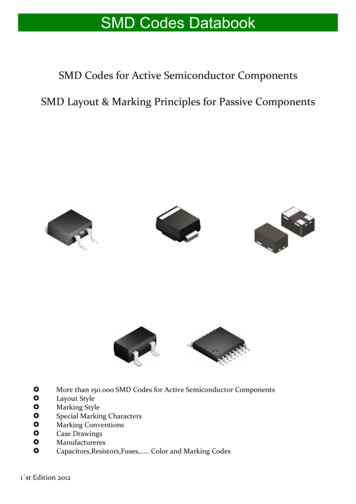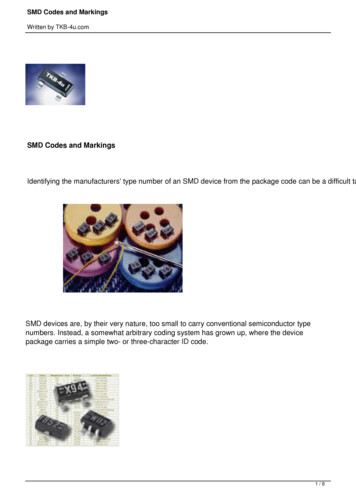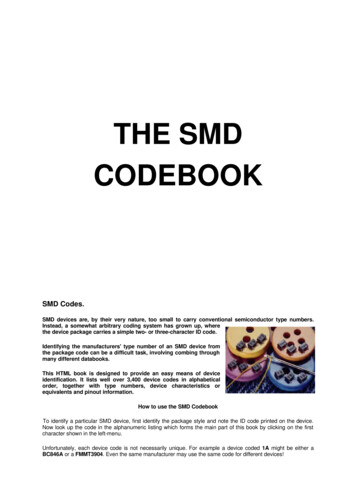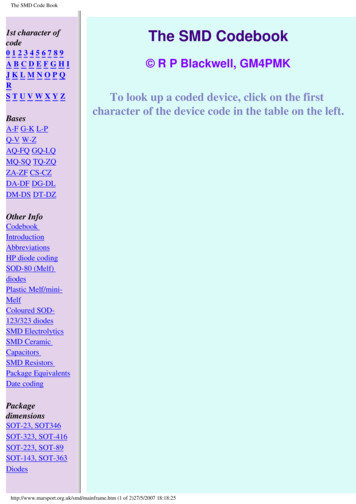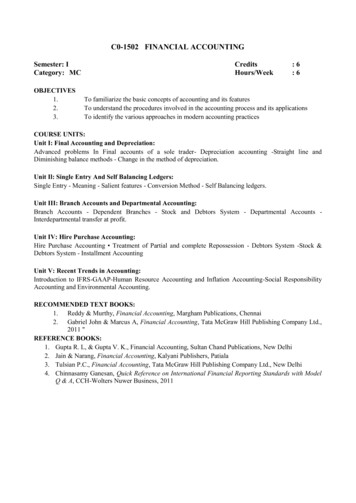
Transcription
ch00 FM 4773.qxd12/29/069:07 AMPage iiiAccountingBest PracticesFifth EditionSteven M. BraggJohn Wiley & Sons, Inc.
ch00 FM 4773.qxd12/29/069:07 AMPage vi
ch00 FM 4773.qxd12/29/069:07 AMPage iAccountingBest PracticesFifth Edition
ch00 FM 4773.qxd12/29/069:07 AMPage iiBECOME A SUBSCRIBER!Did you purchase this product from a bookstore?If you did, it’s important for you to become a subscriber. John Wiley & Sons, Inc. may publish,on a periodic basis, supplements and new editions to reflect the latest changes in the subjectmatter that you need to know in order to stay competitive in this ever-changing industry. Bycontacting the Wiley office nearest you, you’ll receive any current update at no additionalcharge. In addition, you’ll receive future updates and revised or related volumes on a 30-dayexamination review.If you purchased this product directly from John Wiley & Sons, Inc., we have already recordedyour subscription for this update service.To become a subscriber, please call 1-800-225-5945 or send your name, company name (ifapplicable), address, and the title of the product to:mailing address:Supplement DepartmentJohn Wiley & Sons, Inc.One Wiley DriveSomerset, NJ 02-2300www.wiley.comFor customers outside the United States, please contact the Wiley office nearest you:Professional & Reference DivisionJohn Wiley & Sons Canada, Ltd.22 Worcester RoadRexdale, Ontario M9W 1L1CANADA(416) 675-3580Phone: 1-800-567-4797Fax: 1-800-565-6802canada@jwiley.comJohn Wiley & Sons, Ltd.Baffins LaneChichesterWest Sussex, PO19 1UDENGLANDPhone: (44) 1243 779777Fax: (44) 1243 770638cs-books@wiley.co.ukJacaranda Wiley Ltd.PRT DivisionP.O. Box 174North Ryde, NSW 2113AUSTRALIAPhone: (02) 805-1100Fax: (02) 805-1597headoffice@jacwiley.com.auJohn Wiley & Sons (SEA) Pte. Ltd.2 Clementi Loop #02-01SINGAPORE 129809Phone: 65 463 2400Fax: 65 463 4605; 65 463 4604wiley@singnet.com.sg
ch00 FM 4773.qxd12/29/069:07 AMPage iiiAccountingBest PracticesFifth EditionSteven M. BraggJohn Wiley & Sons, Inc.
ch00 FM 4773.qxd12/29/069:07 AMPage ivThis book is printed on acid-free paper.Copyright 2007 by John Wiley & Sons. All rights reserved.Wiley Bicentennial Logo: Richard J. PacificoPublished by John Wiley & Sons, Inc., Hoboken, New Jersey.Published simultaneously in Canada.No part of this publication may be reproduced, stored in a retrieval system, or transmitted inany form or by any means, electronic, mechanical, photocopying, recording, scanning, or otherwise, except as permitted under Section 107 or 108 of the 1976 United States Copyright Act,without either the prior written permission of the Publisher, or authorization through paymentof the appropriate per-copy fee to the Copyright Clearance Center, Inc., 222 Rosewood Drive,Danvers, MA 01923, 978-750-8400, fax 978-646-8600, or on the Web at www.copyright.com.Requests to the Publisher for permission should be addressed to the Permissions Department,John Wiley & Sons, Inc., 111 River Street, Hoboken, NJ 07030, 201-748-6011, fax 201-7486008, or online at www.wiley.com/go/permissions.Limit of Liability/Disclaimer of Warranty: While the publisher and author have used their bestefforts in preparing this book, they make no representations or warranties with respect to theaccuracy or completeness of the contents of this book and specifically disclaim any impliedwarranties of merchantability or fitness for a particular purpose. No warranty may be createdor extended by sales representatives or written sales materials. The advice and strategies contained herein may not be suitable for your situation. You should consult with a professionalwhere appropriate. Neither the publisher nor author shall be liable for any loss of profit or anyother commercial damages, including but not limited to special, incidental, consequential, orother damages.For general information on our other products and services, or technical support, please contactour Customer Care Department within the United States at 800-762-2974, outside the UnitedStates at 317-572-3993 or fax 317-572-4002.Wiley also publishes its books in a variety of electronic formats. Some content that appears inprint may not be available in electronic books.For more information about Wiley products, visit our Web site at www.wiley.com.Library of Congress Cataloging-in-Publication Data:ISBN: 9780470081822Printed in the United States of America10987654321
ch00 FM 4773.qxd12/29/069:07 AMPage vTo John DeRemigis, who convinced methat this was a good idea
ch00 FM 4773.qxd12/29/069:07 AMPage vi
ch00 FM 4773.qxd12/29/069:07 AMPage viiAbout the AuthorSteven Bragg, CPA, CMA, CIA, CPM, CPIM, has been the chief financial officer or controller of four companies, as well as a consulting manager at Ernst &Young and auditor at Deloitte & Touche. He received a master’s degree in financefrom Bentley College, an MBA from Babson College, and a bachelor’s degree ineconomics from the University of Maine. He has been the two-time president ofthe Colorado Mountain Club, and is an avid alpine skier, mountain biker, and certified master diver. Mr. Bragg resides in Centennial, Colorado. He has written thefollowing books published by John Wiley & Sons:Accounting and Finance for Your Small BusinessAccounting Best PracticesAccounting Control Best PracticesAccounting Reference DesktopBilling and Collections Best PracticesBusiness Ratios and FormulasController’s Guide to CostingController’s Guide to Planning and Controlling OperationsController’s Guide: Roles and Responsibilities for the New ControllerControllershipCost AccountingDesign and Maintenance of Accounting ManualsEssentials of PayrollFast CloseFinancial AnalysisGAAP GuideGAAP Implementation GuideInventory AccountingInventory Best PracticesJust-in-Time AccountingManaging Explosive Corporate GrowthOutsourcingvii
ch00 FM 4773.qxd12/29/069:07 AMPage viiiviiiPayroll AccountingPayroll Best PracticesRevenue RecognitionSales and Operations for Your Small BusinessThe Controller’s FunctionThe New CFO Financial Leadership ManualThe Ultimate Accountants’ ReferenceAlso:Advanced Accounting Systems (Institute of Internal Auditors)Run the Rockies (CMC Press)About the Author
ch00 FM 4773.qxd12/29/069:07 AMPage ixFree On-Line Resourcesby Steve BraggSteve issues a free accounting best practices newsletter as well as frequent additional blog postings, and an accounting best practices podcast. You can sign up forfree delivery of both at www.stevebragg.com.ix
ch00 FM 4773.qxd12/29/069:07 AMPage x
ch00 FM 4773.qxd12/29/069:07 AMPage xiContentsPrefacexiiiChapter 1 Introduction1Chapter 2 How to Use Best Practices4Chapter 3 Accounts Payable Best Practices18Chapter 4 Billing Best Practices81Chapter 5 Budgeting Best Practices103Chapter 6 Cash Management Best Practices129Chapter 7 Credit and Collections Best Practices145Chapter 8 Commissions Best Practices187Chapter 9 Costing Best Practices200Chapter 10 Filing Best Practices221Chapter 11 Finance Best Practices244Chapter 12 Financial Statements Best Practices266Chapter 13 General Best Practices295Chapter 14 General Ledger Best Practices333Chapter 15 Internal Auditing Best Practices352Chapter 16 Inventory Best Practices370Chapter 17 Payroll Best Practices414Chapter 18 Policies in Support of Best Practices445Appendix A Summary of Best Practices454Appendix B Supplier Contact Information471Index483xi
ch00 FM 4773.qxdxii12/29/069:07 AMPage xiiContentsIMPORTANT NOTE:Because of the rapidly changing nature of information in this field, this product may be updated with annual supplements or with future editions. Pleasecall 1-877-762-2974 or e-mail us at subscriber@wiley.com to receiveany current update at no additional charge. We will send on approval anyfuture supplements or new editions when they become available. If you purchased this product directly from John Wiley & Sons, Inc., we have alreadyrecorded your subscription for this update service.
ch00 FM 4773.qxd12/29/069:07 AMPage xiiiPrefaceThe accounting department is a cost center. It does not directly generate revenues,but rather provides a fixed set of services to the rest of the company, and is askedto do so at the lowest possible cost. Consequently, the accounting staff is calledupon to process transactions, write reports, create new processes or investigateold ones—while doing so as an ever-shrinking proportion of total corporateexpenses.This cost-based environment is a very difficult one for most accountants, fortheir training is primarily in accounting rules and regulations, rather than in howto run a very specialized department in a cost-effective manner. They find a fewideas for improvements from attending seminars or perusing accounting or management magazines, but there is no centralized source of information for them toconsult that itemizes a wide array of possible improvements. Hence the need for thefifth edition of Accounting Best Practices, which contains 395 accounting bestpractices, of which 61 are new to this edition.This book is compiled from the author’s lengthy experience in setting upand operating a number of accounting departments, as well as by providing consulting services to other companies. Accordingly, it contains a blend of bestpractices from a wide variety of accounting environments, ranging from smallpartnerships to multibillion-dollar corporations. This means that not all of thebest practices described within these pages will be useful in every situation—some are designed to provide quick and inexpensive, incremental improvements,while others are groundbreaking events requiring six-figure investments (or more)and months of installation time. Consequently, each chapter includes a table thatnotes the ease, duration, and cost of implementation for every best practicewithin it. These tables separate best practices into a number of subcategories,and also contain a reference number that is useful for locating the main text foreach best practice within the chapter. Also, a selection of best practices have an“Author’s Choice” graphic posted next to them. These best practices are ones theauthor has found to be particularly effective in improving accounting operations.All best practices are also noted in summary form in Appendix A. In addition,Appendix B contains contact information for most of the suppliers listed in thisbook.xiii
ch00 FM 4773.qxdxiv12/29/069:07 AMPage xivPrefaceThough this book is the central source of best practices information for theaccountant, there are several other books available that specialize in smaller nicheswithin the accounting area. Each of these books contains many additional bestpractices not found in Accounting Best Practices. These include the author’s Inventory Best Practices (Wiley, 2004), Billing and Collections Best Practices (Wiley,2005), Payroll Best Practices (Wiley, 2005), and Fast Close (Wiley, 2005).STEVEN M. BRAGGCentennial, ColoradoJuly 2006
ch00 FM 4773.qxd12/29/069:07 AMPage xvAccountingBest PracticesFifth Edition
ch00 FM 4773.qxd12/29/069:07 AMPage xvi
ch01 4773.qxd12/29/068:53 AMPage 1Chapter 1IntroductionA chief executive officer (CEO) spends months deciding on a corporate strategy.The plan probably includes a mix of changes in products, customers, and markets, as well as demands for increased efficiencies or information in a number ofexisting areas. The CEO then hands off the plan to a group of managers who arequite capable of implementing many of the changes, but who scratch their headsover how to squeeze greater efficiencies or information out of existing departments in order to meet their strategic goals. This is where best practices comeinto play.A best practice is really any improvement over existing systems, thoughsome consultants prefer to confine the definition to those few high-end and veryadvanced improvements that have been successfully installed by a few worldclass companies. This book uses the broader definition of any improvement overexisting systems, since the vast majority of companies are in no position, in termsof either technological capabilities, monetary resources, or management skill, tomake use of truly world-class best practices. Using this wider definition, a bestpractice can be anything that increases the existing level of efficiency, such asswitching to blanket purchase orders, signature stamps, and procurement cards tostreamline the accounts payable function. It can also lead to improved levels ofreporting for use by other parts of the company, such as activity-based costing,target costing, or direct costing reports in the costing function. Further, it canreduce the number of transaction errors, by such means as automated employeeexpense reports, automated bank account deductions, or a simplified commissioncalculation system. By implementing a plethora of best practices, a company cangreatly improve its level of efficiency and information reporting, which fits nicelyinto the requirements of most strategic plans.One can go further than describing best practices as an excellent contributorto the fulfillment of a company’s strategy, and even state that a strategy does nothave much chance of success unless best practices are involved. The reason isthat best practices have such a large impact on overall efficiencies, they unleash alarge number of excess people who can then work on other strategic issues, aswell as reduce a company’s cash requirements, releasing more cash for investment in strategic targets. In addition, some best practices link company functionsmore closely together, resulting in better overall functionality—this is a singularimprovement when a company is in the throes of changes caused by strategyshifts. Further, best practices can operate quite well in the absence of a strategic1
ch01 4773.qxd212/29/068:53 AMPage 2Introductionplan. For example, any department manager can install a variety of best practiceswith no approval or oversight from above, resulting in a multitude of beneficialchanges. Thus, best practices are a linchpin of the successful corporate strategy,and can also lead to improvements even if they are not part of a grand strategicvision.The scope of this book does not encompass all of the best practices that acompany should consider, only those used by the accounting department. Thisarea is especially susceptible to improvement through best practices, since it is heavilyprocedure-driven. When there are many procedures, there are many opportunitiesto enhance the multitude of procedure steps through automation, simplification,elimination of tasks, error-proofing, and outsourcing. Thus, of all the corporatefunctions, this is the one that reacts best to treatment through best practices.Chapter 2 covers a variety of issues related to the implementation of bestpractices, such as differentiating between incremental and reengineering changes,circumstances under which best practices are most likely to succeed, and how toplan and proceed with these implementations. Most important, there is a discussion of the multitude of reasons why a best practice implementation can fail,which is excellent reading prior to embarking on a new project, in order to beaware of all possible pitfalls. The chapter ends with a brief review of the impactof best practices on employees. This chapter is fundamental to the book, for itserves as the groundwork on which the remaining chapters are built. For example,if you are interested in modifying the general ledger account structure for use byan activity-based costing system, it is necessary to first review the implementation chapter to see how any programming, software package, or interdepartmentalissues might impact the project.Chapters 3 through 17 each describe a cluster of best practices, with a functional area itemized under each chapter. For example, Chapter 8 covers a varietyof improvements to a company’s commission calculation and payment systems,while Chapter 17 is strictly concerned with a variety of payroll-streamliningissues related to the collection of employee time information, processing it intopayments, and distributing those payments. Chapter 13 is a catchall chapter. Itcovers a variety of general best practices that do not fit easily into other, morespecific chapters. Examples of these best practices are the use of process-centering,on-line reporting, and creating a contract-terms database. Chapters 3 through 17are the heart of the book since they contain information related to nearly 400 bestpractices.For Chapters 3 through 17, there is an exhibit near the beginning that showsthe general level of implementation cost and duration for each of the best practices in the chapter. This information gives the reader a good idea of which bestpractices to search for and read through, in case these criteria are a strong consideration. For each chapter, there are a number of sections, each one describing abest practice. There is a brief description of the problems it can fix, as well as noteson how it can be implemented, and any problems one may encounter while doing so.Each chapter concludes with a section that describes the impact of a recommended
ch01 4773.qxd12/29/06Introduction8:53 AMPage 33mix of best practices on the functional area being covered. This last section almostalways includes a graphical representation of how certain best practices impactspecific activities. Not all the best practices in each chapter are included in thisgraphic, since some are mutually exclusive. This chapter layout is designed to givethe reader a quick overview of the best practices that are most likely to make asignificant impact on a functional area of the accounting department.Chapter 18 contains a set of policies designed to assist in best practices implementations. Appendix A lists all of the best practices in each of the precedingchapters. This list allows the reader to quickly find a potentially useful best practice. It is then a simple matter to refer back to the main text to obtain more information about each item. Appendix B contains contact information for every supplierlisted in this book, in case the reader wants additional information related to specific suppliers.This book is designed to assist anyone who needs to either improve the efficiency of the accounting department, reduce its error rates, or provide better information to other parts of a company. The best practices noted on the followingpages will greatly assist in attaining this goal, which may be part of a grand strategic vision or simply a desire by an accounting manager to improve the department.The layout of the book is extremely practical: to list as many best practices as possible, to assist the reader in finding the most suitable ones, and to describe anyimplementation problems that may arise. In short, this is the perfect do-it-yourselffix-it book for the manager who likes to tinker with the accounting department.
ch02 4773.qxd12/29/069:08 AMPage 4Chapter 2How to Use Best PracticesThis chapter is about implementing best practices. It begins by describing thevarious kinds of best practices and goes on to cover those situations where theyare most likely to be installed successfully. The key components of a successfulbest practice installation are also noted. When planning to add a best practice, itis also useful to know the ways in which the implementation can fail, so there is alengthy list of reasons for failure. Finally, there is a brief discussion of the impactof change on employees and the organization. Only by carefully considering allof these issues in advance can one hope to achieve a successful best practiceimplementation that will result in increased levels of efficiency in the accountingdepartment.Types of Best PracticesThis section describes the two main types of best practices, each one requiringconsiderably different implementation approaches.The first type of best practice is an incremental one. This usually involveseither a small modification to an existing procedure or a replacement of a procedure that is so minor in effect that it has only a minimal impact on the organization, or indeed on the person who performs the procedure. The increased level ofefficiency contributed by a single best practice of this type is moderate at best,but this type is also the easiest to install, since there is little resistance from theorganization. An example of this type of best practice is using a signature stampto sign checks (see Chapter 3); it is simple, cuts a modest amount of time fromthe check preparation process, and there will be no complaints about its use.However, only when this type of best practice is used in large numbers is there asignificant increase in the level of efficiency of accounting operations.The second type of best practice involves a considerable degree of reengineering. This requires the complete reorganization or replacement of an existingfunction. The level of change is massive, resulting in employees either being laidoff or receiving vastly different job descriptions. The level of efficiency improvement can be several times greater than the old method it is replacing. However, thelevel of risk matches the reward, for this type of best practice meets with enormous resistance and consequently is at great risk of failure. An example of thistype of best practice is eliminating the accounts payable department in favor of4
ch02 4773.qxd12/29/069:08 AMPage 5The Most Fertile Ground for Best Practices5having the receiving staff approve all payments at the receiving dock (see Chapter3); it involves the elimination of many jobs and is an entirely new approach to paying suppliers. A single best practice implementation of this sort can reap majorimprovements in the level of accounting efficiency.Thus, given the considerable number and size of the differences between theincremental and reengineering best practices, it is necessary to first determineinto which category a best practice falls before designing a plan for implementing it. Given the difficulty of implementation for a reengineering project, it mayeven be necessary to delay implementation or intersperse a series of such projectswith easier incremental projects, in order to allow employees to recover from thereengineering projects.The Most Fertile Ground for Best PracticesBefore installing any best practice, it is useful to review the existing environmentto see if there is a reasonable chance for the implementation to succeed. The following bullet points note the best environments in which best practices not onlycan be installed, but also have a fair chance of continuing to succeed: If benchmarking shows a problem. Some organizations regularly comparetheir performance levels against those of other companies, especially thosewith a reputation for having extremely high levels of performance. If there isa significant difference in the performance levels of these other organizationsand the company doing the benchmarking, this can serve as a reminder thatcontinuous change is necessary in order to survive. If management sees andheeds this warning, the environment in which best practices will be acceptedis greatly improved. If management has a change orientation. Some managers have a seeminglygenetic disposition toward change. If an accounting department has such aperson in charge, there will certainly be a drive toward many changes. If anything, this type of person can go too far, implementing too many projectswith not enough preparation, resulting in a confused operations group whosenewly revised systems may take a considerable amount of time to untangle.The presence of a detail-oriented second-in-command is very helpful forpreserving order and channeling the energies of such a manager into themost productive directions. If the company is experiencing poor financial results. If there is a significantloss, or a trend in that direction, this serves as a wake-up call to management,which in turn results in the creation of a multitude of best practices projects.In this case, the situation may even go too far, with so many improvementprojects going on at once that there are not enough resources to go around,resulting in the ultimate completion of few, if any, of the best practices.
ch02 4773.qxd12/29/069:08 AMPage 66How to Use Best Practices If there is new management. Most people who are newly installed as managersof either the accounting department or (better yet) the entire organizationwant to make changes in order to leave their marks on the organization. Thoughthis can involve less effective practice items like organizational changes or anew strategic direction, it is possible that there will be a renewed focus onefficiency that will result in the implementation of new best practices.In short, as long as there is a willingness by management to change and a goodreason for doing so, then there is fertile ground for the implementation of a multitude of best practices.Planning for Best PracticesA critical issue for the success of any best practices implementation project is anadequate degree of advance planning. The following bullet points describe thekey components of a typical best practices implementation plan: Capacity requirements. Any project plan must account for the amount ofcapacity needed to ensure success. Capacity can include the number of people,computers, or floor space that is needed. For example, if the project teamrequires 20 people, then there must be a planning item to find and equip asufficient amount of space for this group. Also, a project that requires a considerable amount of programming time should reserve that time in advancewith the programming staff to ensure that the programming is completed ontime. Further, the management team must have a sufficient amount of timeavailable to properly oversee the project team’s activities. If any of theseissues are not addressed in advance, there can be a major impact on the success of the implementation. Common change calendar. If there are many best practices being implementedat the same time, there is a high risk that resources scheduled for one projectwill not be available for other projects. For example, a key software developermay receive independent requests from multiple project teams to develop software, and cannot satisfy all the requests. To avoid this, one should use a single change calendar, so that planned changes can be seen in the context ofother changes being planned. The calendar should be examined for conflictsevery time a change is made to it, and also be made available for generalreview, so that all project teams can consult it whenever needed. Contingencies. Murphy’s Law always applies, so there should be contingencies built into the project plan. For example, if the project team is being setup in a new building, there is always a chance that phone lines will not beinstalled in time. To guard against this possibility, there should be an additionalproject step to obtain some cellular phones, which will supply the team’scommunications needs until the phone lines can be installed.
ch02 4773.qxd12/29/069:08 AMPage 7Planning for Best Practices7 Dependencies. The steps required to complete a project must be properlysequenced so that any bottleneck steps are clearly defined and have sufficientresources allocated to them to ensure that they are completed on time. Forexample, a project planning person cannot set up the plan if there is no project planning software available and loaded into the computer. Consequently,this step must be completed before the planning task can commence. Funding requirements. Any project requires some funding, such as the purchase of equipment for the project team or software licenses or employeetraining. Consequently, the project plan must include the dates on which funding is expected, so that dependent tasks involving the expenditure of thosefunds can be properly planned. Review points. For all but the smallest projects, there must be control pointsat which the project manager has a formal review meeting with those peoplewho are responsible for certain deliverables. These review points must be builtinto the plan, along with a sufficient amount of time for follow-up meetings toresolve any issues that may arise during the initial review meetings. Risk levels. Some best practices, especially those involving a large proportion of reengineering activities, run a considerable risk of failure. In thesecases, it is necessary to conduct a careful review of what will happen if theproject fails. For example, can the existing system be reinstituted if the newsystem does not work? What if funding runs out? What if management support for the project falters? What if the level of technology is too advancedfor the company to support? The answers to these questions may result inadditional project steps to safeguard the project, or to at least back it up witha contingency plan in case the project cannot reach a successful conclusion. Total time required. All of the previous planning steps are influenced by oneof the most important considerations of all—how much time is allocated tothe project. Though there may be some play in the final project due date, it isalways unacceptable to let a project run too long, since it ties up the time ofproject team members and will probably accumulate extra costs until it iscompleted. Consequently, the project team must continually revise the existing project plan to account for new contingencies and problems as they arise,given the overriding restriction of the amount of time available.The elements of planning that have just been described will all go for naught ifthere is not an additional linkage to corporate strategy at the highest levels. Thereason is that although an implementation may be completely successful, it maynot make any difference, and even be rendered unusable, if corporate s
accountant, there are several other books available that specialize in smaller niches within the accounting area. Each of these books contains many additional best practices not found in . Accounting Best Practices. These include the author's . Inven-tory Best Practices (Wiley, 2004), Billing and Collections Best Practices (Wiley, 2005 .

